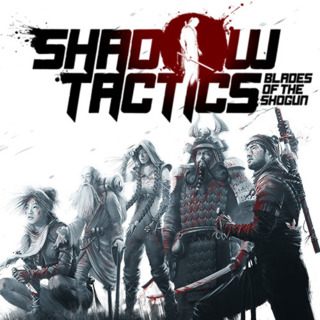INTRO:
Commandos was a peculiar game for its time. It was about war, but it was also a game where the player characters are heavily outnumbered and outgunned – if they so choose to fight their enemies head-on. Rather, the player would be making use of their furtiveness and unique skills to systematicapiclly remove enemies.
Incidentally, such a formula is readily applicable to just about any setting where the enemy has armies of mooks and the player characters are highly skilled operatives. It so happens that Shadow Tactics: Blades of the Shogun is one such game.
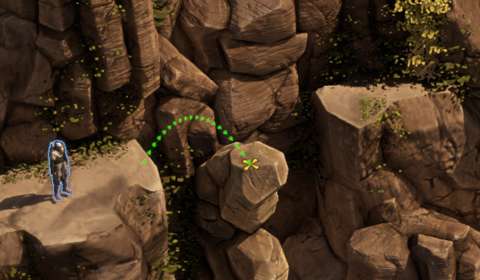
PREMISE:
The game is presumably set in a time just after the end of Sengoku Jidai, the era in which feudal Japan was plunged into total war. The first scenario is about the “last battle of the war”, which would end in victory for the Shogun (who is presumably a Tokugawa). Gunpowder weapons were still around, alongside older weapons like swords and spears.
It would not take long for a history-observant person to realize that the game’s setting is really loosely based on the Edo Period. The Shogun lacks a name, most characters are fictitious, the fashion sense of the Japanese people is uncannily gaudy and their spoken language is too post-modern, e.g. having romaji words mixed in.
In other words, this game should not be praised for trying to be believable in terms of historical references.
With that out of the way, the story is about rooting out a conspiracy against the Shogunate, specifically one that would spark another war for the heart of Japan. The player characters are agents of the Shogun against this conspiracy, by choice, honour, coin or simply circumstance.
The player should not really expect very complex story-telling here. Its story is certainly much better than those in the Commandos games, but it is merely decent at best. Veteran followers of story-telling can already predict the plot twist that would happen based on the introduction of characters alone.
GAMEPLAY – OVERVIEW:
Like the Commandos games, the player controls a bunch of player characters that would not do anything on their own until the player gives them instructions. In other words, the player will have to hold their hands, from start to the end.
However, unlike the Commandos titles, the gameplay involves a 3D environment instead of a stack of 2D layers. This allows player characters to better gain height over their enemies. Indeed, three of the player characters are nimble and very capable of getting to places where they are not so easily spotted.
Still, the player would be doing many of the same things that the player would have done in the Commandos titles. The player would be exploiting the behaviours of enemies and other NPCs, either for the purpose of getting around them or eliminating them.
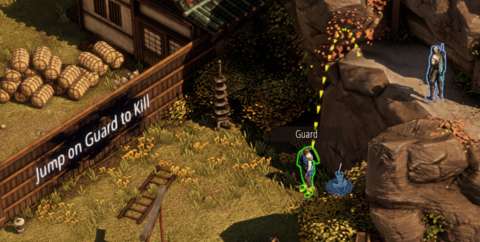
PLAYER CHARACTERS:
There are five player characters in total. The player is introduced to one first: Hayato, a shinobi formerly of the (now destroyed) Iga village. He has skills that represent just about every basic gameplay element in a Commandos title, and his introduction conveniently coincides with a tutorial sequence.
The player is then introduced to Mugen, a samurai that apparently has no issues working with shinobi or people of shady backgrounds for that matter. From Mugen’s introduction, the player learns that all player characters share some basic capabilities, such as crouching, crouch-walking (as goofy as this looks), climbing ladders and using doors.
Later, the player is introduced to characters that have more specializations. The player is then told how to use their abilities, through the implementation of circumstances that just so happen to be solvable with their special abilities. Afterwards, the player is expected to learn how to use their skills and abilities together for maximum effect.
HEALTH:
The durability of each player character is represented with red pips. Mugen, being the toughest of the lot, has the most pips; Takuma, being already elderly and having had an amputation, has the least. Obviously, they die if they lose all their hit points, but as long as they have one left, they can function at full performance.
To allay death, each player character happens to have to a first-aid kit. This restores three hit points, but there will be no more. Still, generally, if a player character took more than one HP of damage, something has gone very wrong and the player should just reload a game-save.
SOFT GAME-OVER:
Having a character die does not end the mission outright; there will be no unpleasant cut-offs to loading screens and such. No player has ever liked that, and this game will not do it.
Rather, it does something else that is perhaps just as bad. The player can try to continue with the mission, but without the character, certain mission triggers and scripts simply will not activate. The player might as well waste time in other ways.
MOVING ABOUT:
The player characters have multiple modes of movement. Two of these are walking and running (or in Takuma’s case, hobbling along). That said, there is only one occasion for using these: when there are no more enemies around. This is because standing or moving upright gets a player character spotted immediately by enemies or not-friendly civilians.
This is not unlike the earlier Commandos titles, and this would have been incredibly annoying if the player does not have a reliable place to stash unneeded player characters away.
The player might have characters run, if only to quickly cover distances across unobserved terrain. However, this only works if they are not making too much noise. (There will be more on noise later.)
All characters are capable of lurking and sneaking, including Mugen despite being a samurai. (He has no issues with fighting enemies ‘fairly’, as long as he is serving his duty.) When player characters sneak, they are much harder to see; this will be elaborated later when enemies’ line of sight are explained.
If a player character has been instructed to perform an action on a target that is outside of the range of his/her action, he/she will attempt to move closer to the target. The player character’s path-finding is not that great at keeping them stealthy, however. Therefore, the player will have to monitor them as they move towards their targets. Again, this is not unlike the Commandos titles.
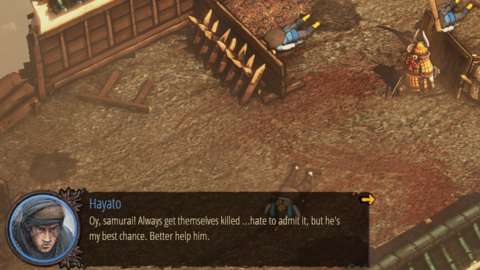
NOISE WHEN MOVING:
Three of the player characters can walk and run about without making noise, thanks to the soft soles of their footwear, which is much better suited for stealth. They do make a bit of noise when they are running on hard surfaces, however.
Mugen’s armor makes a small rustle when he walks, whether on soft or hard ground. When he runs, he really makes a ruckus. Similarly, Takuma walks with a cane and has a peg leg. Having him hobble around quickly has him making a lot of noise.
Again, there are very few reasons to have characters walk or run when they could just sneak about. When they are sneaking, no one makes any noise, not even Mugen or Takuma.
If characters move on puddles of water – whether from the rain or in stagnant pools – they will make loud splashes, no matter what movement mode that they are using.
DISCOVERY BY ENEMIES:
There are two mechanisms by which enemies would be roused from their usual routines. The first mechanism is sight-dependent; if they can spot a player character or a yet-undiscovered corpse for a few in-game seconds, they are immediately alerted to the character’s presence. The second mechanism is hearing-dependent; if they can hear something suspicious, they will go over to investigate. There will be more elaboration on these mechanisms.
LINE OF SIGHT:
Only NPCs are subjected to the system of line of sight; the player characters – through the player, are ever omniscient about the whereabouts of enemies. (There are cutscenes in which they make observations on things that are supposed to be out of their sight too. Of course, there is the argument that they have done their due reconnaissance.)
NPCs have slightly narrow arcs of vision – around 40 degrees. Some have wider arcs, typically enemies whose jobs are being sentries.
There is also the length of their sight. The early-game enemies typically have shorter lines of sight than the later ones, which can see quite far.
Their cones of vision are made more complex with separation into two zones. The solidly filled (albeit translucent) zones are no-go zones; if the player characters are not within or behind opaque cover, they are guaranteed to be spotted soon. The banded zones are where player characters can skulk about without being seen, but running or walking would get them spotted. Corpses that are in these zones are not spotted too.
This innovation lets the player stash unused player characters in places that do not have walls or such other opaque cover, as well as give the player some time to deal with corpses.

HIGHLIGHTS & VISION MARKERS:
Not unlike the Commandos games, the player can click on an enemy or NPC to reveal his/her field of vision. This helps the player time movement past them. Of course, the player is not able to reveal the visions of multiple NPCs; that would have led to a mess of overlapping fields.
SWINGING LINE OF SIGHT:
Most enemies are vigilant enough to swivel their heads around, even if they are standing still. Although this means that they have wider fields of vision, this also means that their actual arcs of visions are oscillating; the player can see these when a sentry is highlighted. (Their heads also move in tandem with the vision arcs.) This lets the player time sneaks or runs past them.
Generally, only sentry enemies swing their vision arcs around, but some enemies on the move do swivel their heads.
FILLING FIELD WHEN SPOTTING INTRUDERS:
When enemies spot a player character, they do not raise the alarm immediately. This is not unlike the Commandos games. However, Shadow Tactics introduces an innovation, thanks to advancements in coding techniques for visual effects.
When enemies have spotted a player character, their fields of vision begin to be replaced with a yellow fill, starting from where they are. The NPCs also centre their field of vision on the player character. If the fill reaches the player character, he/she is spotted.
(The use of green and yellow can be a problem to those who have colour-blindness for these hues. There does not appear to be any option for swapping colours.)
In-game time also slows down, thus giving the player some means of responding to this occurrence. However, if the player character is not at the edges of the spotting NPC’s field of vision, discovery is more than likely to be certain. If the player character manages to break line of sight before this happens, the NPC resumes his/her usual routine.
Nevertheless, the yellow fill remains, though it will recede over time. If the player character is spotted again, the fill continues from where it left off.
EFFECT OF HEIGHT AND PARTIAL COVER ON LINE OF SIGHT:
One of the tropes of the Commandos titles and its ilk is that NPCs tend not to look up. Those in this game are the same.
However, NPCs can still see one level above or below them. On the other hand, if these higher or lower places occur in what should be the solid fill region of their fields of vision, these parts of their field of vision is downgraded to the banded one. This also applies to the immediate area behind partial cover, like low stacks of crates, thickets and cattle (of all things that can be considered cover).
Learning to spot these differences in the NPCs’ fields of vision is useful, because it helps sneaking past them at close distances.
STEEP HEIGHTS:
Steep height differences cut off fields of vision outright. This means that player characters can be right underneath enemies without them noticing. Steep heights also nullify the noise of moving about. However, it will not nullify gunshots; enemies directly above player characters, even those who are several floors above, will still hear them.
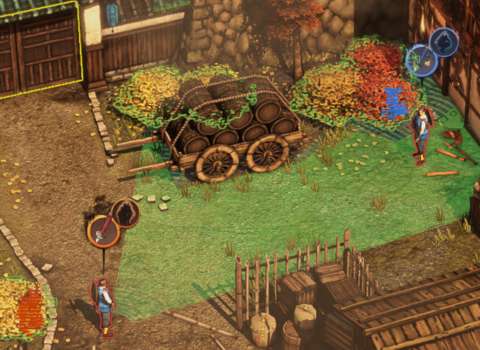
NIGHT MISSIONS & LIGHT SOURCES:
Some missions take place during the night. At first glance, this might seem to be in the favour of the player characters, especially for the two ninja and Yuki.
Night reduces the reach of all NPCs’ fields of vision. This makes it very easy to creep past them, even at close ranges. However, to compensate, most NPCs wield torches. The torches will not personally help them, but they will help others that are further away see whatever that is illuminated around them.
That said, light sources convert all banded portions of any field of vision into solidly filled ones. This means that if a player character is in an illuminated area, he/she will be spotted as soon as the field of vision of any NPC falls on him/her.
PUTTING OUT LIGHT SOURCES:
When an NPC with a torch goes down from an indirect attack, his torch falls down on the ground, but it remains lit. It can be put out by having player characters move onto them, which can be risky.
Non-portable light sources may or may not be extinguishable. The player characters can do nothing about roaring campfires, but they can put out street torches and lanterns. However, extinguished street torches and lanterns will attract the attention of any NPC, who would then relight them. This might be a good thing, if the player intends to lure them away from their default locations.
NOISE:
Player characters can perform actions that make noise. The most notable of these actions is running about on hard ground. Mugen and Hayato also make noise when they carry bodies, especially those of soldiers. Takuma always make noise if he is not sneaking about.
Killing people also makes some noise, as does knocking them out. In particular, killing enemy samurai with Mugen results in quite a ruckus, so this should be done against samurai that are on their lonesome (which is usually the case most of the time).
Firing pistols will make noise obviously. However, their noises have surprisingly short radii, thanks to Takuma’s craftsmanship. (He is the team’s egghead.) This is not so for Mugen’s hand cannon, which is much louder. Of course, Takuma saves the best for himself; his rifle makes little noise when it discharges.
Hayato can also throw stones; amusingly, he calls this a technique in his Japanese voice-over. The stones do make a loud noise, which can startle and distract low-grade enemies.
Perhaps the least believable implementation of noise is Hayato’s shuriken. It causes noise with considerable reach when it lands, which goes against the concept of the shuriken. This is likely a deliberate design, one implemented with the intention of balancing against the reusability of Hayato’s shuriken.
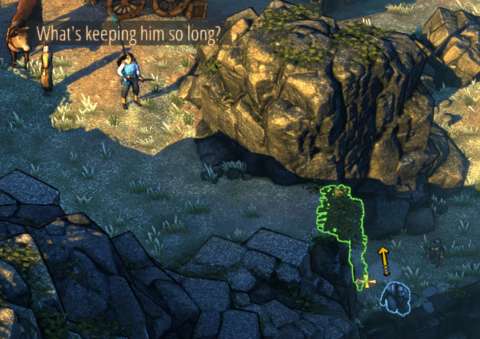
HEARING:
Any NPCs that are within the range of any noise made by the player characters will become suspicious. If the NPCs can reach the source of the noise within 50 paces, they will come over to check it out. However, if they are too far away, they simply dismiss it as a waste of time. The only exception is noise made from firearm discharges or kills; these will raise alarms immediately.
There are some scenarios where these are exceptions, like battlefields and the vicinity of training grounds for firearm-equipped soldiers. These scenarios can be quite interesting, because the usual precautions about not making too much noise do not need to be applied.
TAKUMA’S KUMA:
Takuma has a well-trained tanuki by the (peculiar) name of Kuma. The tanuki will not fight, of course, and it will not be attacked either; he is too cute to die. (In fact, Kuma is rendered invulnerable.)
With an order from Takuma, from any distance and across any obstacle, Kuma would start making noise and acting cute. Gullible NPCs like civilians and low-grade soldiers would come over to check him out, though they would lose interest eventually.
The main thing to observe about Kuma’s ability is that Kuma can move about and then make noise alternatingly. This lets Kuma lure gullible NPCs all over the place, as long as they have not lost interest and are within range of Kuma’s antics. For example, a low-grade guard that is standing sentry can be lured away for several dozen paces, and then slain when out of sight of other NPCs.
SHORT MEMORIES:
Not unlike NPCs in the Commandos games and other titles like Legend of Sherwood, the NPCs in this game have short memories of disturbances. There is no “cry wolf” limit; they can be distracted over and over with the same kind of disturbance.
HAULING BODIES:
Sooner or later, the player characters will need to hide the bodies of people that they have slain or knocked out. This invariably means moving their bodies, which is a physically challenging matter.
Mugen can readily carry bodies around, due to his considerable physique. In fact, he can carry two bodies and run around doing so. Hayato has to haul a body on his shoulder, and walks about at a slower pace. Since both are obviously moving about upright, this makes them easier to spot.
Yuki and Aiko do not have the upper-body strength to haul bodies like Hayato and Mugen can. Rather, they have to drag bodies around. They count as sneaking while doing so, which might be useful in getting corpses through places with no opaque cover to where they can be tossed away.
Takuma cannot haul any bodies. He is too old for that.
Hauling the bodies of enemies who are clearly armoured will generate noise. This is especially so for samurai. In the case of civilians, they cause little noise when they are moved about, due to their light clothing.
CLIMBING LADDERS AND VERTICAL FOLIAGE:
There are ladders here and there. Anyone can climb these, even Takuma and his tanuki. The player characters do not seem to be made more visible to NPCs when they are climbing ladders, interestingly. Likewise, NPCs do not appear to notice player characters that are climbing plant growths on walls.
Only the nimble player characters can climb foliage. Mugen is too heavy and Takuma is not able.

ACROBATICS:
The civil engineering of the Edo period apparently had a lot of cobbled roofs and ropes hung across rooftops so that banners can be displayed. Incidentally, these gave advantages to ninja.
Only the nimble player characters can creep across the ropes and rooftops. Still, there are three of them, and between the three of them, they can bring enough expertise to where they end up. Keeping this in mind will be quite important later in the game, when there are more of such structures.
NPCs can see the player characters moving across rooftops and ropes, but only if they are on the same vertical level or higher, without anything obstructing their sight.
SCALING HOOKS:
Hayato comes with a scaling hook; Yuki would get one later too. Aiko, being a kunoichi, has one too. The hooks allow these characters to exploit the rings that are affixed to buildings. (The rings are presumably there for special occasions where banners are to be displayed.) No one will notice them zipping upwards or downwards.
The main purpose of this gameplay element is to separate the three nimble characters from the other two, more so than anything else in the game. Still, it can be used for some clever solutions, as will be described shortly.
JUMPING OFF HIGHER LEVELS AND LEDGES:
One of the things that the three nimble player characters can do is to leap off from higher platforms/levels onto lower ones. They can also jump from one ledge to another, as long as they are close enough for the hop. The player characters will be doing this so that they can reach places that other characters cannot. (No NPCs can do these jumps, by the way.)
The jumps look great, but there is a problem with them: they are location-sensitive. The player has to hover the mouse cursor around until he/she finds the exact spots where these jumps can be done.
LEAPING ATTACKS:
The three nimble player characters can jump off from a higher level to land on an NPC in order to either knock him/her out, or stab the person. This can be used to slay enemies that stray too near buildings or platforms. However, since the targets are moving and the jumping attacks do have specific ranges, the window of opportunity is small. The player can work around this by using the Shadow mode feature, which will be described later.
Like jumping, leaping attacks are location-sensitive. This is generally the main problem with these attacks; finding the spots where these attacks become doable is rather finicky.
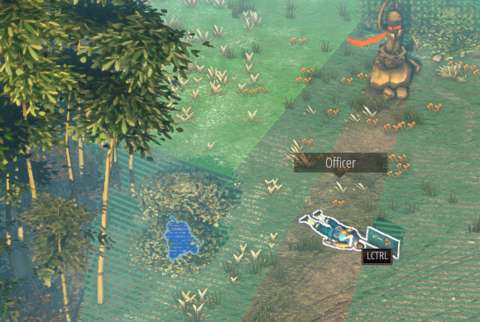
MUGEN’S SWORD WIND:
Mugen is a sword-master who knows how to use both blades of his daisho (his sword and short sword set) to great effect. This is implemented in the gameplay as his “sword wind” move, through which he can outright kill non-samurai NPCs within a small radius. It has a long cool-down, so the player should not expect Mugen to be able to wipe out incoming enemy reinforcements easily.
However, the cool-down is still short enough that the player can use the technique to sporadically remove groups of enemies. Indeed, the player would using this a lot against enemy patrols (more on these later).
ACCIDENTS:
Some mission areas have precarious objects, like wood planks that have been hoisted up with a crane but not put away yet. Another example is a boulder that is about to be loosed from the face of a hill, due to the erosion of time.
The player characters, especially the nimble ones, are particularly capable of reaching and messing with these, either to make a ruckus that draws people away from their location, or killing them in what looks like an accident.
Accidents do not raise alarms when they kill people. They will draw some NPCs over, especially those who saw the people die, but they will eventually return to their original locations. The corpses are left behind where they are, and will no longer attract any attention unless the player characters move them.
DISPOSING OF BODIES:
If the player is playing every mission safe, chances are, the player would be having the player characters kill a lot of people. Obviously, leaving corpses around is not wise. Like the Commandos titles, NPCs can find them, and understandably, they will be very alarmed.
In the Commandos games, the most that the player can do is stash corpses away somewhere out of sight such that there is a macabre pile of them. In this game, the player has some additional means of hiding bodies, specifically means that cause the bodies to de-spawn permanently.
When the player is controlling a character that is hauling around a body, hovering the mouse cursor over things show whether the player can drop the body there or not.
There are thickets that can somehow hide bodies, even multitudes of them. There are wells that corpses can be tossed into. There are bodies of deep water, such as rivers and oceans that bodies can be sunk into. There are chasms that bodies can be chucked into. (Finding the spots to chuck the bodies can be problematic though, because this is a location-sensitive action.)
Indeed, it will be rare to find mission areas where the player cannot hide corpses so readily. (These rare missions happen late into the playthrough.)
If a corpse was made by killing someone in a bloody manner, the corpse seems to spill blood. However, the blood disappears quickly, which is convenient. Thus, the player does not need to worry about cleaning up the scene of the crime.
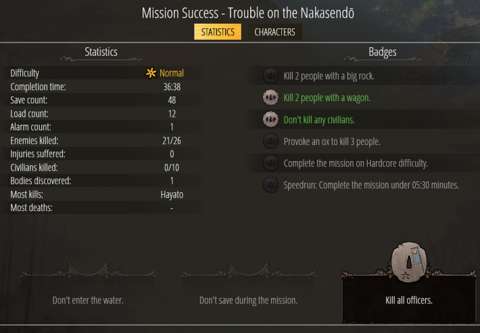
KNOCKING OUT FOOLS:
Instead of killing enemies, the player can knock them out instead. Knocking out enemies can be done by right-clicking on the primary weapons of the player characters, with the exception of Takuma, who is too old for this kind of physical exertion.
The knocking-out animation depends on the player character. Aiko seems to take the longest to take down an NPC, due to her use of techniques that strike multiple locations on the victim.
Takuma can also convert his grenades into gas grenades, which can knock out just about everyone, including samurai. However, doing so eats into his supplies for bombs. The player will also need to deal with a whole bunch of unconscious NPCs.
UNCONSCIOUS NPCS WAKING UP:
After an NPC is knocked out, three stars circle above his/her head in a comical manner. The stars go out one by one as the NPC gets closer to regaining consciousness. When the NPC regains consciousness, he/she would obviously be alarmed.
If the NPC is a civilian and he/she did not notice his/her attacker, the NPC will run towards the nearest guard station or building with a door; they favour guard stations first. After they have entered these buildings they de-spawn; this is convenient. However, if they spot the player character along the way or if something else spooked them, their current behaviours get superseded by their scripting for alarm.
If the NPC is a soldier and did not notice his attacker, the soldier will still be suspicious and will search where he is for any assailant. The soldier will also attempt to return to where he was attacked.
If any NPC did see his/her attacker before he/she is knocked out, the alarm will be raised when the NPC wakes up.
Amusingly, the player can extend the time that an NPC is out by hitting the NPC again. There is no limit to this; repeated blunt trauma to the head is not an issue.
HIDING UNCONSCIOUS NPCS:
Unconscious people cannot be disposed of so easily. For example, putting them into a thicket will not cause their models to disappear.
Of course, the player can dump them into bodies of water or toss them off a cliff, but this counts as killing them. If the player’s intention is to kill them, the player could have the player characters do so in the first place.
However, in the case of NPCs that are civilians, the player has a solution; simply dumping them into a building will suffice. Even if they saw their attackers, they will not raise the alarm when they wake up because they de-spawn shortly after.
In the case of NPCs that are soldiers, stuffing them into a building will not cause them to de-spawn. When they wake up, they become suspicious if they did not see their attackers. If they did, they will raise the alarm after exiting the building.
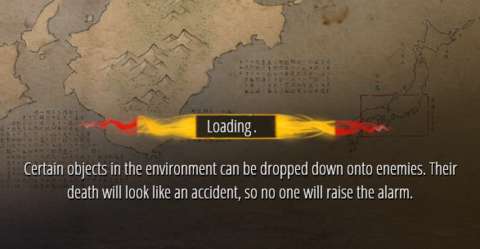
THICKETS:
There are thickets and bushes that the player characters can hide in. Even hedges can hide them, including the hulking Mugen. Unsuspecting enemies will not notice them even if they are mere feet away. However, suspicious NPCs receive an upgrade to the solid-filled portion of their vision; they can see any hiding player characters that happen to be in this portion.
BASKETS & CABINETS:
There are large baskets and cabinets that are meant to store supplies. They happen to be big enough to chuck bodies into too. Strangely, this also causes corpses to de-spawn.
Any suspicious enemies that check the baskets or cabinets will not discover any of the corpses that had been chucked into them. However, if the player characters happen to be hiding in them, they will be discovered and attacked.
Strangely, there is no limit to the space capacity of baskets and cabinets. The player can stuff all five player characters into any of them without much of a problem, even if it seems too small. The player characters will not point this out either.
SWIMMING IN WATER:
The three nimble player characters can swim and snorkel; even Yuki knows how to, despite not having had any ninja training. They can stay underwater indefinitely – even in water that is supposed to be freezing cold.
As long as nobody saw them enter the water, they can swim anywhere without anyone noticing. There is no caveat to swimming faster either.
HIDING IN BUILDINGS:
There are no missions that happen in-doors, although there are at least two indoors scenes that suggest that such missions could have been possible. That said, if there are any buildings in a mission, the most that the player could do with them is to use them as hiding places.
Buildings are good hiding places, as long as pursuing enemies did not notice the player characters go into them.
Enemies that enter buildings render that building unusable for a while. However, as long as they are not suspicious, they will not discover any player characters that are hiding there. Suspicious enemies that check buildings will violently evict any player characters that are hiding in them.
Networks of caves and secret tunnels also count as buildings. These appear in some missions that take place in mountain establishments. However, NPCs never seem to acknowledge their presence, even if the entrances are wipe open.
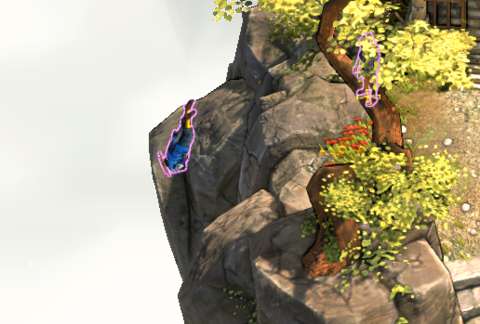
CHOOSING WHICH ENTRANCE TO EXIT:
Some buildings have multiple entrances and exits. The player can choose which of these that a player character in the building should exit from. Alternatively, directing a player character in a building to move anywhere outside will automatically have them leaving the building through the exit that is nearest to the destination.
However, the player characters that are already outside will not use a building to get to somewhere, even if it conveniently has entrances connecting one point to another on the path in between where the player characters are and the destination. Rather, they will try to move around the building instead.
BUMPING INTO NPCS:
NPCs may not hear or see the player characters, but if the latter are too near to the former, the NPCs will notice them after a few seconds. Likewise, if a moving player character touches an NPC, the NPC will notice that immediately and would be understandably alarmed that a shady person is next to them.
SNOW:
As Yuki would put it, snow is a treacherous friend. (Her name means “snow”, by the way.)
Whenever characters move on snow, they leave behind prints. Somehow, NPCs can recognize that the footprints left behind by the player characters are those of suspicious people, despite the prints that other people leave behind.
Anyway, any NPC that spotted the player characters’ footprints will automatically become suspicious and will follow the prints towards the latest ones. This can lead to enemies finding the hiding place of the player characters, for better or worse. However, this can also be used to lure enemies away from their locations. This is because all NPCs will follow the footprints, regardless of what types of NPCs they are.
Footprints eventually disappear over time. If the player intends to avoid raising suspicion or lure enemies over, the player will have to consider their rate of disappearance.
MUGEN HAULING ROCKS AND BARRELS AROUND:
Mugen’s physique is such that he can haul large rocks and barrels around. He has to be upright when doing so, however, but then, hauling these things is not an act of subtlety.
Rocks are meant to be tossed at enemies. This requires Mugen to somehow stay out of sight while waiting for enemies to pass close enough to toss the rock; he cannot toss it very far, by the way. Still, if there happens to be a tightly packed group of enemies, such as a samurai with a couple of retainers, the rock can be an efficient way to clear them out.
There are barrels of gunpowder in some mission areas, usually those that take place on a battlefield or that include a training area for firearms. These are usually related to certain mission objectives, so their presence usually means something might have to be blown up. That said, barrels do not immediately blow up when tossed (fortunately). Rather, they have to be placed by Mugen (and only Mugen), and have to be shot to detonate them.
TAKUMA’S BOMBS:
Takuma has small but rather powerful bombs that can outright kill anyone caught in the explosion. Considering that he is the egghead of the team, this is not surprising.
What is surprising is his throwing arm. He can toss a bomb at a considerable distance, with him being well outside of the effective range. Indeed, there are some mission objectives – especially assassination-related ones – that can be achieved using his bombs. Of course, he does not have a lot of them.
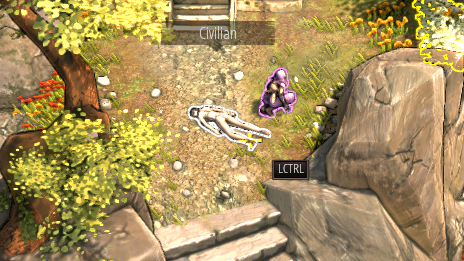
TAKUMA’S RIFLE:
As mentioned already, Takuma has a well-crafted noise-suppressed rifle. Using it changes the player’s mouse cursor into something that resembles the view through a lens. Takuma’s rifle has no known limit to its range, so the player can have the cursor move just about anywhere. However, the player has to be mindful of anything that might obstruct his aim; if this happens, the lens gets a red tint.
Takuma has a limited number of rounds to fire. He does not always have consistent amounts of bullets. There is a mission where he begins with five rounds, whereas in another he has just three. In missions that have objectives that must be shot with firearms, Takuma always reserves one bullet for his rifle.
RELOADING:
When a character fires his/her firearm, he/she will immediately begin the reloading process. This is because the player is considered to be still using their firearms, even after firing.
Generally, there is no reason to continue firing after the first shot. If the player has to, something has gone wrong, the alarm has already been raised and new enemies would be spawning in. The effort and ammunition would have been spent in vain.
BLACKPOWDER BOXES:
Here and there, the player may find gunpowder casks. No one other than Takuma may use these. Presumably, he has materials on him to quickly convert the gunpowder into more shots for his rifle or even enough charge for his grenades; the others do not. The game will prioritize refilling his bullet reserves first, however.
YUKI’S WHISTLE & MUGEN’S SAKE:
Yuki’s whistle lures NPCs to where she is when she whistled, which can be a problem if there is no nearby place to hide; the NPCs will also search the immediate area. Takuma’s raccoon dog has to be manually controlled all the way to where the player wants victims to be, and the raccoon dog (or rather, the player) can unwittingly lure more than one person over.
Mugen’s bottle of good-branded sake is a more reliable lure and with less hassle. It will always lure the victim over to exactly where it is. If there is more than one person that saw the bottle, only one will go over to it; which person it would be is randomized though.
The person who collected the bottle will keep it indefinitely. It can only be taken back after the person has been knocked out, or killed; only Mugen can retrieve the bottle.
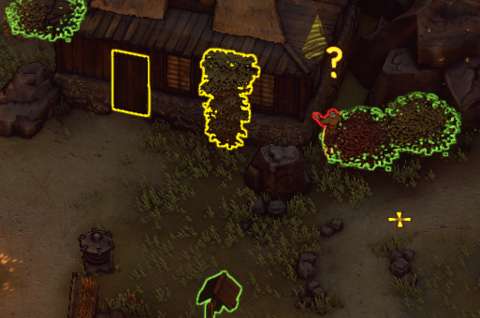
RETRIEVING GEAR:
Mugen, Yuki and Hayato have items that are reusable, but they have to be retrieved after they are used. This can be a problem if there are NPCs looking in the direction of the items. Fortunately, the items can be recovered while they are sneaking. They also automatically retrieve any of their items that have just been used, without the player having to manually direct them to do so.
AIKO’S DISGUISE:
Hayato is good at hands-on killing, and Yuki can lure people onto her trap. With Hayato and Yuki around, there is not much that Aiko can do for the team if she is not doing her trade of impersonating ladies of importance.
For whatever reason, Aiko does not already come with a set of disguises. (Presumably, she needs locally sourced clothes for an effective disguise.) That said, each mission that has her as a playable character always has at least two sources from which she can obtain clothes for a disguise.
If the source is a living person, it does not matter much to the gameplay whether the person is killed or knocked out. For the case of killing the person, one would expect that the clothes would be stained with blood, making it less useful as a disguise. This is not the case.
There are at least two types of disguises, each with a different model for Aiko in disguise. However, all of them are functionally the same; the differences are just there for aesthetic gratuitousness.
Anyway, after she has obtained her disguise, it takes a while for Aiko to change into it. Of course, the process is visually obscured and amusingly accelerated with a flourish from a smoke bomb (which she cannot use in any other way by the way). Aiko has to stand upright during this transformation though, so the player should make sure that she either has a safe spot to change or enough time to do so.
After she has donned her disguise, low-level NPCs completely ignore her presence. Aiko is always upright, consequently, but this is not an issue as long as she does not stray into the line of sight of samurai. Speaking of which, samurai can somehow see through her disguise, even at the furthest regions of their fields of vision.
(Presumably, the best argument for this is that the samurai know enough local high-class ladies that they are suspicious of whom they do not recognize. Still, this reasoning can seem far-fetched, especially in missions that take place far away from civilization.)
The main value of her disguise is that she can distract just about any NPC (except samurai of course), and for indefinitely too. Any NPC that she distracts will be looking at her all the time. (Aiko is a very attractive lady.) This of course makes them vulnerable to attacks, or lets the player sneak other player characters behind them.
Aiko can also distract an entire patrol. This is convenient for coordinated attacks on them. (Coordinated attacks will be described later.)
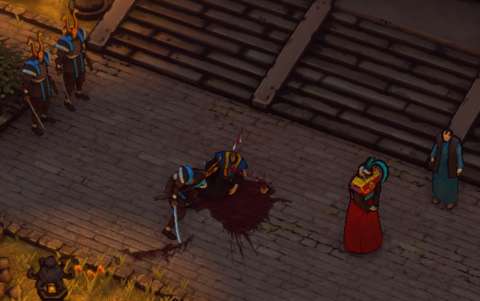
SHADOW MODE:
The edgily-named gimmick of “Shadow Mode” is what the player uses to have the player characters make simultaneous moves. This gimmick uses a queue system that lets the player plan actions that the player characters would execute simultaneously. The list of actions is shown on the left side of the screen, together with controls that let the player remove unwanted actions. There are other controls, such as triggering each planned action separately from the others (for whatever reason).
However, ultimately, there are not many good reasons to use Shadow Mode frequently. This is because one of the problems with Shadow Mode is that the gameplay is not paused. The player must be hiding player characters in safe spots when using it.
If the target of the shadow mode sequence is a moving one, the player has to move the camera to where they are so that inputs can be made.
For all the time that the player would spend fiddling with the controls to queue actions, the player could actually be having the player characters do things. Indeed, players who are gunning for the speed-run achievements would not use them.
The other major problem is that the player does not get to delay one action behind the others, or put one ahead of the rest. In other words, Shadow Mode cannot account for any time differences between the actions due to their animations or the distances between the player characters to their targets.
Consequently, there are only a few situations where Shadow Mode is practically useful. For example, when Aiko is distracting a patrol of three soldiers, the player can have two other player characters sneak behind them before using Shadow Mode to plan a simultaneous killing of all three.
ENEMY BEHAVIOURS - FOREWORD:
As long as an attack on an enemy is effective on him, the enemy would die outright, usually after some animations. Therefore, other than their aesthetic differences and the extra trouble that samurai pose (more on this later). the main practical factor in differentiating between them is their behaviours.
SENTRY:
Firstly, there is the single-facing sentry. This sentry stands around, doing nothing much other than looking ahead and oscillating his vision. Unless his back is to a corner, he is vulnerable to sneak attacks.
Secondly, there is the rotating sentry. This sentry may rotate in place to look at another location. Thus, the player must consider his observation cycle in order to sneak past him or eliminate him when there is a gap in his vigilance.
Third, there is the relocating sentry. He moves from one spot to the next, spending some time playing sentry at each spot before moving on. This is the hardest sentry to pin down.
PATROL:
The patroller moves in a circuit, rarely spending much time in any spot. There are even some patrollers who never stop anywhere. Obviously, these are more difficult to deal with.
PATROL SQUADS:
Some patrollers move together as a squad. Raising the suspicion of anyone in the squad causes the entire squad to become suspicious. They then move in formation towards the source of the disturbance.
One of the persons in the squad is always the leading member. Even when they move to investigate a disturbance, the leader will always be at the front. This is useful to keep in mind if the player intends to use Shadow Mode against them.

CONVERSING GUARDS:
Some enemies appear to be talking to each other right from the start of the mission. These enemies have fixed fields of vision, making them much easier to approach from the sides.
If the player raises the suspicion of any one of them, the other(s) would become suspicious too. They then move towards the cause of the suspicion. However, they are not as coordinated as patrol squads.
If disguised Aiko interrupts the conversation, only the enemy that is the target of the distraction would be distracted. The other one would eventually leave.
REPORTING GUARDS:
Some patrollers and some sentries behave like conversing guards. In their case, the patroller moves to the sentry to communicate with the latter. During the short time that they communicate with each other, they behave as conversing guards.
They do have one additional behaviour over conversing guards; they will notice that their colleagues are missing, if the player has dealt with them. For example, the sentry has timed scripts that check for the presence of the patroller; if the patroller is not around, the sentry becomes suspicious. Likewise, if the sentry is not around when the patroller comes by, the patroller becomes suspicious.
This behaviour can be used to peel one or the other away from their routines. Besides, the suspicious one will not alert anyone else.
GUARD STATIONS:
Guard stations are otherwise unassuming buildings where reserve soldiers reside. The guard stations are usually identified by a tall vertical banner with colours that match the colours of the local enemies. These guard stations spawn additional enemies whenever a state of alarm is raised; there does not appear to be any limit to the guards that they can spawn.
The additional guards have darker clothes that depict them as reinforcements. They always behave as patrol squads.
ALARM:
The state of alarm is usually depicted with exclamation marks appearing over the models of enemies. This usually happens after any NPC has confirmed the presence of the player characters. It does not matter if the NPC that has done so had the time to utter anything aloud, e.g. screaming. The state of alarm is raised as soon as the confirmation has been done.
Obviously, any state of alarm is bad. To elaborate anyway, all enemies in the map become aware of the player characters’ presence. Only those that are in the vicinity will move to converge on their last known positions, however. Most importantly, all guard stations in the map will spawn squads that converge on the positions too.
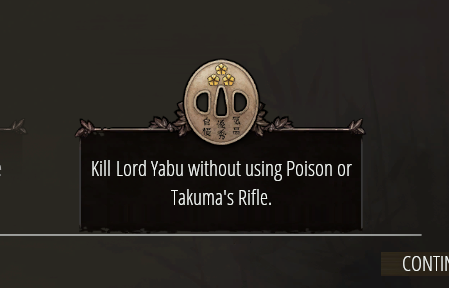
ASHIGARU:
The low-grade enemies are ashigaru, i.e. soldiers drawn from the peasantry, or low-born families with martial traditions. The ashigaru are never armed with katana, but they are armed with yari (spears) and teppo (guns). Either weapon configuration is visually obvious, so if the player wants to get into a fight with them for whatever reason, the player will want to know that the ones with guns do not need to get close at all.
STRAW HATS:
Most of the ashigaru are easily distracted. However, some of them are more serious than the rest. Conveniently, these wear their straw hats so that the player can recognize them, even in circumstances when the hats are not practical.
Their seriousness means that the straw hats will not deviate from their routines, at least not for long. If they had heard some noise, they merely stop for a few seconds before returning to their routine. If they saw Mugen’s sake bottle, they dismiss it after a few seconds.
The only thing that can distract them is Aiko’s disguise. Despite their terse sternness, they will still converse with her.
SAMURAI:
The samurai that the player would face would be quite far off from what the player would consider to be the archetypal samurai. Indeed, they seem to have gear that was top-of-the-line at the end of the Sengoku era.
They have their weapons out all the time. This is understandable if they are in places that they are currently guarding and they need to look menacing. However, they are also this edgy even at places where they are supposed to show some decorum, like their lord’s castle.
All samurai NPCs are armed with tanegashima matchlock pistols, and appear to favour these over their swords when close combat is not needed. This can seem to go against the image of the archetypal samurai who mainly uses his daisho (his sword and short sword). Still, there is the argument that this is a habit that remained from the days of the Sengoku era, the latter days of which is dominated by firearms. Gameplay-wise, this means that enemy samurai can attack from ranged and when up-close.
Speaking of up-close combat, no one other than Mugen can stand up to them in melee. Any player character that is not Mugen that attacks them with their close combat implements will be countered and subsequently killed outright. This happens even if the player characters approach them at their blind spots.
Mugen kills enemy samurai in three strokes. Their fight will last several seconds, during which Mugen could be spotted. However, Mugen is somehow skilled enough to kill them without them being able to alert others.
The samurai appear to be wearing armor plates, e.g. the ones that were developed in response to the introduction of firearms. The plates do have gameplay effects; they will block any low-calibre round, such as those from most of the player characters’ matchlock pistols and Takuma’s rifle. There is no way to shoot at their uncovered spots.
However, the armor does nothing to dissipate the blunt trauma from the shot. They will drop to their knees in the direction of where the shot came from and they cannot use their swords. They will however fire their pistols at any player character that they can see.
On the other hand, their disorientation reduce their field of vision, they do not cry out to alert others and they do not look around, meaning that the player can have another character sneak up to them. They happen to be vulnerable to sneaky kills in this state. However, if they manage to fire any shots, they will immediately raise the alarm.
Throughout the game, the samurai will be major hindrances, often standing at locations that are already observed by other enemies, or overlooking places where a disguised Aiko should get into. After a certain plot twist, they will become even more difficult to deal with.
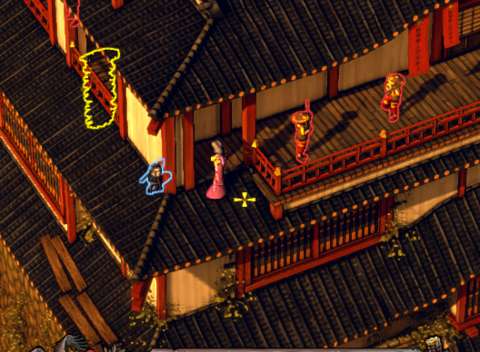
VISUAL DESIGNS:
Although most of the in-game visuals are definitely not at the level seen in the promotional materials (which are understandably deceptive), Blades of the Shogun is still a beautiful game. The first mission alone introduces the player to the view of a sheer cliff face and pretty lighting. There will be more scenery to be seen later, such as a mountain temple, a prison built into a cliff side, and a high lord’s multi-storey castle.
The game does resort to some visual effects to enhance its visuals without using techniques that increase graphics overhead. There is subtle cel-shading around the edges of objects and characters, making the effect of shadowing more noticeable. There are a lot of normal-mapped decals, such as those for footprints.
Next, there are the designs for the characters’ models. For example, there is Mugen’s old armor, which convincingly appears to be of the old foldable kozane construction. Indeed, there are scenes in which Mugen is not in his armor, and his armor has been folded up and placed elsewhere.
The other samurai have armor that do not entirely match the era. They may have cuirasses that resemble real-life tameshi gusoku plates (minus the unsightly dents), but their shoulder pauldrons are impractically big.
The get-up of the shinobi characters (and Yuki) are a lot less believable, especially considering that they are not suited for missions in cold places (especially Aiko’s) or swimming in rivers for that matter (they look they will be a problem when they are soaked). Of course, there can be the excuse that ninja training had prepared Hayato and Aiko for this, and that Yuki learned from the school of hard knocks.
Still, they do not look too far off from the archetypal shinobi of myths, even though their capabilities are that of Sengoku-era ninja. Watching them creep across rooftops and banner ropes, especially one after the other, can be entertaining (albeit unbelievable – tightrope walking is not safe for multiple people attempting it).
The game does seem dependent on colour codes for quite a number of things. Some are not too terribly dependent, such as the colours of the player character’s models; their silhouettes are different enough to not make this a problem. Some others are less excusable. For example, the line of sight system uses fills of different colour, but has no other visual forms.
Still, there are visual designs that contribute to the gameplay and which have been effectively designed with something other than colour codes. The visuals for the segmentation of NPCs’ fields of vision are particularly notable examples.

VOICE-ACTING:
Players who have watched or played one too many anime or anime-based games would find the voice-overs all too familiar.
The English voice-acting is made by British people trying to sound stereotypically Japanese, or trying to do medieval-speak. The silliest moments are the rare occasions when the voice-actors forget the accent that they are supposed to have.
The Japanese version is no less corny. Mugen and Takuma have peculiarly forced laughs. Hayato is edgy. Aiko is sultry but cold. Yuki is one more chirpy anime girl, and is the most egregious in uttering one too many words in romaji. (Romaji words are practically English words pronounced with Japanese phonetics.) Indeed, Hayato’s and Aiko’s voice-overs sometimes have romaji words slip in too.
Still, there is a plot twist in the story, after which the voice-acting in both languages actually changes for the better. Of course, to elaborate more would be to describe spoilers. Yet, this is when character development happens, and both voice-over sets appear to deliver on the changes in their demeanours and motivations.
The dialogue between the party members are much like those in modern-day Western RPGs. To elaborate, some characters may reach some location that triggers a script to start a conversation between two team members. It does not matter what the team members are doing and whether they are close enough to hear each other; it just happens.
This can be goofily entertaining. Alternatively, it can be irritably mocking if something stressful is happening and the player needs to exert control of the situation.
MUSIC:
As to be expected of a game that is set in Edo-era Japan, the player can expect much of the music to use Japanese traditional instruments whenever it can. However, there are some tracks that use Western instruments, especially for ominous moments like a certain plot twist that happens at the two-thirds milestone of the game. There are also tracks where both Japanese and Western instruments are combined to hair-raising effect, such as the one used for the main menu.
SOUND EFFECTS:
Most of the sound effects that the player would hear are for the ambience. With the exception of missions that take place in cities, most mission areas are windy; the player can see trees making limited animations with their canopies and grass rustle as the wind whispers through them.
Despite the high camera level, some sound effects that happen close to the ground has been made clearer to the player such as the sounds of feet trudging through snow. This helps the player notice incoming enemies (though their vision has range that is longer than one screen length).
The most satisfying noises are those of the player characters eliminating their enemies. These occur together with the characters’ voice-overs for when their lethal actions are successful, further compounding on the sense of satisfaction.
That said, the player will want to keep an ear out for the audio cues for when enemies have spotted and/or detected the player characters. However, since the game runs in real-time all the time, there is probably not much that the player can do when such an occurrence happens off-screen.
Although it would generally be a bad scene if the player is hearing gunshots and explosions, there are two missions which take place during sieges. The din of battle is particularly prevalent, and they do have gameplay effects too; the noise from gunfire has reduced range.
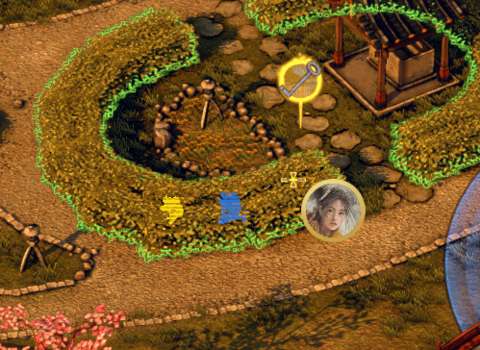
CONCLUSION:
Shadow Tactics: Blades of the Shogun is a competently-made game, despite the dependence on things like colour-coding and location-sensitive control inputs. Its use of 3D graphics is also commendable, because it allows for environments where large objects can affect gameplay like line of sight while giving the player the means of rotating the camera. Thus, in the history of games that the first Commandos has inspired, this game has worked around the problem of limited viewing angles.
Furthermore, the game’s use of two sets of vision for NPCs and the ability for player characters to go into sneak mode have mitigated the problem of having to find places to stash unused characters while using the other characters. This makes gameplay in this game a lot less frustrating than those in previous Commandos-like games.
